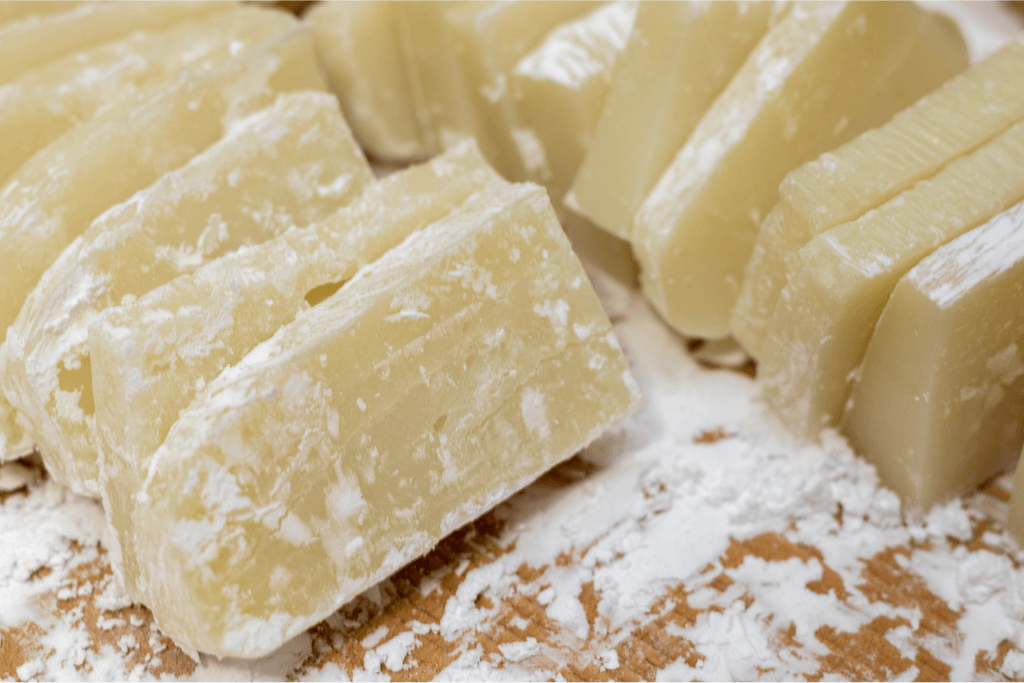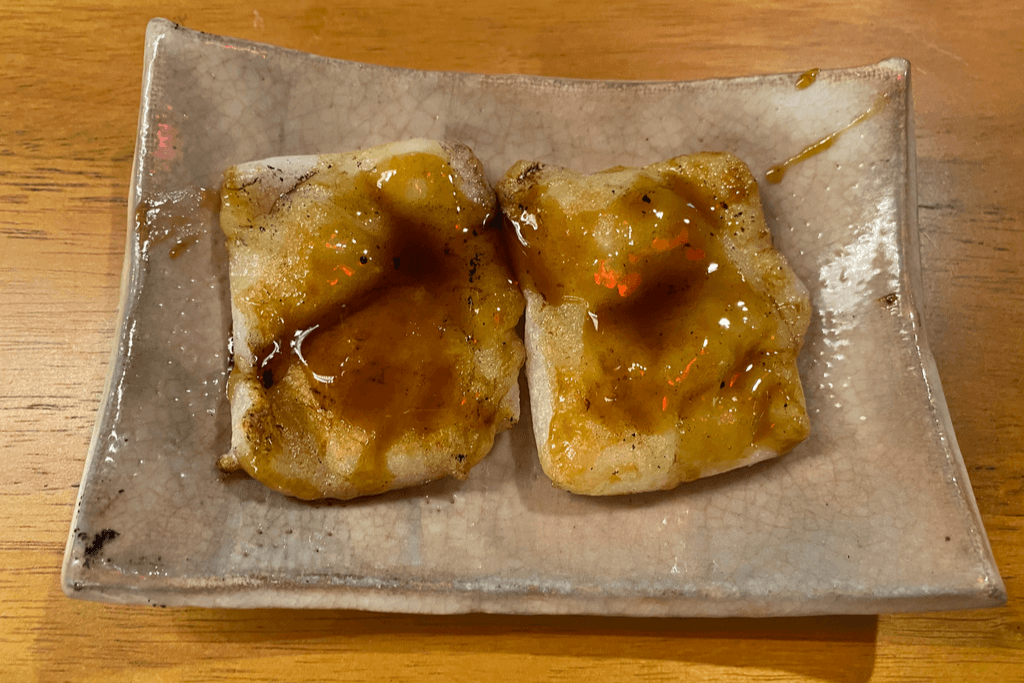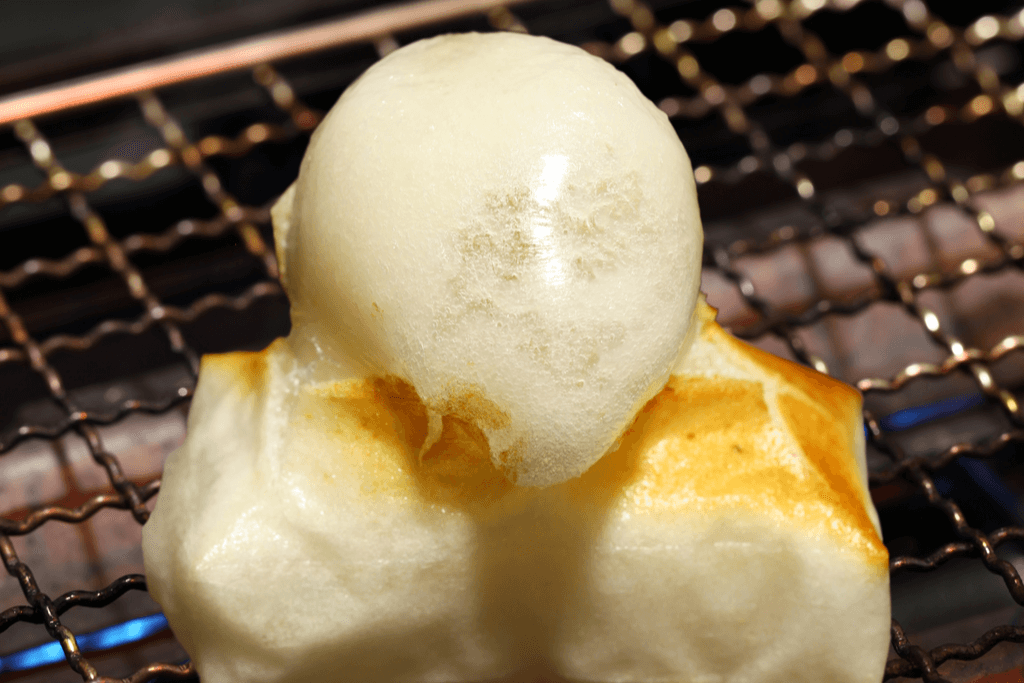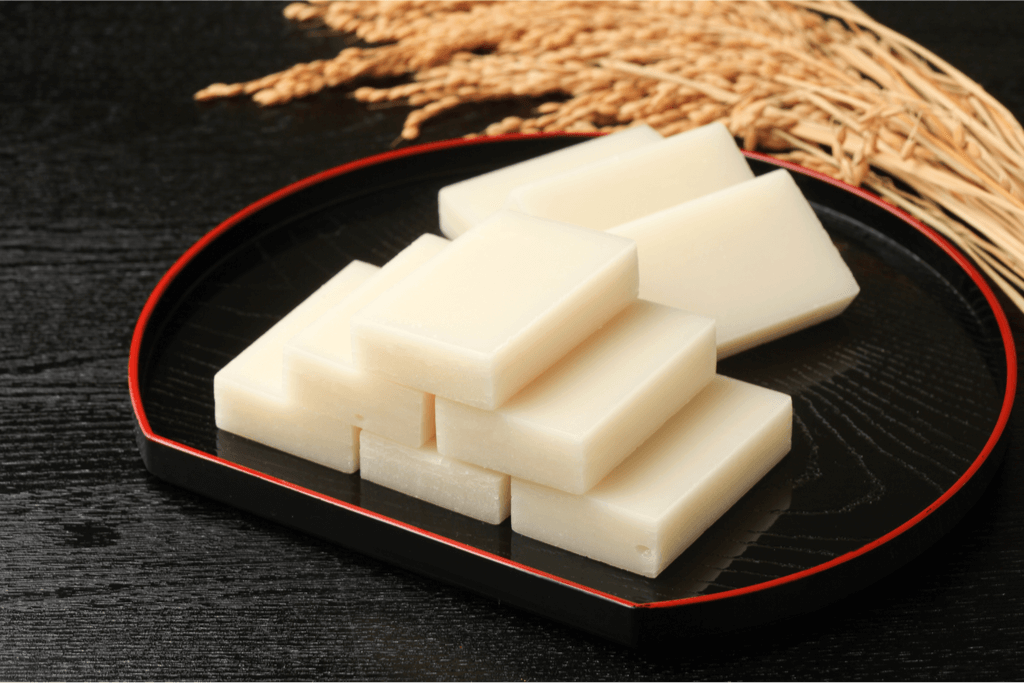Japanese kirimochi (cut mochi) is a dried and packaged rice cake, also known as mochi. Drying it makes it shelf stable for many months, which makes it a popular pantry food, usually coming in convenient individual packages. Crispy on the outside and chewy on the inside, kirimochi is a staple Japanese food.
When subjected to heat, kirimochi turns chewy and flavor-neutral, with a texture similar to melted mozzarella. If it’s grilled or baked, the outside will become crispy. This profile fits Japan’s love of textural contrasts – ingredients such as kanten (agar-agar) jelly and konnyaku (yam) are used in dishes not because of their flavor but because of their unique gelatinous textures.
Table of Contents
ToggleWhat is Kirimochi?
Kirimochi come in firm white slabs and it refers to dried and cut mochi that is shelf stable. Like fresh mochi, it is made only with glutinous rice. Meaning there is no added sugar, and it is not sweet.

It comes in a rectangle shape and wrapped individually in plastic. When you take it out of the package, it feels like a hard brick, so the kirimochi needs to be heated up to become chewy. Because kirimochi is shelf stable, it lasts for a long time unopened.
Traditional kirimochi is made with glutinous rice or glutinous rice flour as the main ingredient, which is pounded by hand into a soft and chewy texture. It’s a convenient and versatile food because it’s available year-round, shelf-stable, and eaten in sweet and savory options.
A Holiday Treat
Kirimochi is also commonly eaten during Japanese national holidays. One of the more popular traditional applications of kirimochi is isobe yaki (baked mochi with seaweed). This izakaya staple features a baked mochi cake with soy sauce, wrapped in a toasted sheet of nori (seaweed) and eaten with dinner.
Another common application is grilling mochi then adding it to soups. Kirimochi is commonly used in ozone (the traditional New Year’s soup) and shiruko (a soup made of crushed adzuki beans).
Do you also crave Japanese mochi? Check out Sakuraco! Sakuraco delivers traditional Japanese snacks, teas, sweets, and snacks from local Japanese makers directly to your door for you to get your mochi fix in!
How to Use
Making mochi from glutinous rice takes time and effort. So why not make a quick stop at the supermarket to buy kirimochi instead? To eat it, grill it in the toaster oven, microwave it, cook on a dry frying pan, or add it directly to hot soup. It can be very sticky once cooked, so a tip is to use wet chopsticks to pick it up. You can eat it in salty and sweet dishes. For savory dishes, it’s a topping for ozone and okonomiyaki (Japanese savory pancakes).
You can also eat it with nori for isobeyaki, soy sauce, grated daikon (white radish), and natto(fermented soybeans). For sweet dishes, you can eat with anko (red bean paste), kinako (roasted soybean flour), and black sesame seeds. Some common desserts including kirimochi are mochi ice cream and different types of daifuku (small round mochi).

The most standard and easiest way to eat kirimochi is to add plain soy sauce and sugar. Because mochi itself does noy have a strong flavor, you can try other flavors too, like cheese, bacon, garlic, or if you like it sweet, honey or jam. Try combining your favorite flavors to enjoy kirimochi in your own and unique way!
Ways to Cook Kirimochi
Toaster Oven
The easiest and fastest method is by using a toaster oven because the heat surrounds the mochi and all you need to be careful is not to burn it. Setting the timer at about 5 minutes, as soon as it puffs and gets lightly browned it is done!
Gas Stove Grill
Another way to cook it is by using the gas stove grill. Japanese gas stoves (gas cooktops) often have a small drawer which is a grill. In this type of grill, the food is cooked below the flame. By laying the mochi on aluminum foil and closing the drawer, since the heat only comes from above, it is better to turn it over when the top side is toasted. Bake the other side until puffy and browned and serve!
Frying Pan
Frying pans are also a convenient way to cook kirimochi. If you use a non-stick frying pan you can bake kirimochi without getting the pan sticky. You can also lay a baking sheet on top of the pan before putting the kirimochi, or alternatively use a drop of vegetable oil. First, heat the pan and bake the kirimochi over medium heat. Turn it over when the bottom side is puffed and brown. Wait till the whole kirimochi is puffed and enjoy.
Shichirin
For an extra charcoal taste, try using a shichirin (a small Japanese charcoal stove). Shaped like a large bowl it is easy to move around and can be found in old Japanese houses. Shirichin is pretty rare and by no means the most convenient cooking tool today.

Nevertheless, it’s still worth a try because the effects and flavor charcoal heat cooking gives to the foods is uniquely delicious. The method is basically the same as using a frying pan and is a little faster.
Microwave
Using the microwave is the fastest way to cook kirimochi. All you have to do is to wet the surface of the mochi, put it on a microwavable dish, cover with plastic wrap, and heat it for about one minute (in 500W).
Instead of water, you can lay a piece of baking sheet, nori or kinako underneath the mochi to prevent it from sticking to the dish. The time depends on the microwave you are using, the wattage, and the number of mochi you are heating at once. Be careful not to overdo it – it will literally explode and melt.
If you’re worried, check every 30 seconds to make it to your preference. Mochi cooked using a microwave is soft and stretchy, but does not have the crispness of the baked kirimochi.
Boiling in a Pan
Boiled mochi is used in dishes like ozoni or zenzai (with sweet red bean paste). The use is not limited to these dishes, and recently varieties in Chinese or Korean tastes as well as western tastes are enjoyed among Japanese people.
To boil kirimochi, lay it in a saucepan, put cold water so that it completely covers the kirimochi, the deeper the better, and turn on the heat. Gently move around the kirimochi so that it does not stick to the pan. Once the water comes to a boil, turn the heat to low and let it simmer for a couple of minutes. Take it out when it is soft and before the surface starts to melt.
Tips to Make the Most of Your Kirimochi
Store in a dark place with low humidity, like a pantry. It has a shelf life of several months as it is vacuumed packed, or packed with a deoxidizer.
Dried mochi can be preserved for a few days at normal temperature during Japanese winter but can get moldy if left out for too long. If you plan to eat kirimochi ASAP just keeping it in the refrigerator will suffice.

If the amount is more than you can consume in a couple of weeks, freezing is recommended. To freeze kirimochi, first wrap each kirimochi tightly with plastic, put a few of them in a resealable storage bag, and put it in the freezer.
Overall, kirimochi is a favorite food in Japanese cooking, that can be eaten as a snack or a side dish. It’s good for any occasion, especially during the Japanese New Year and tsukimi season.
Have you tried kirimochi before? What is your favorite way to cook and eat kirimochi? Let us know in the comments below!










